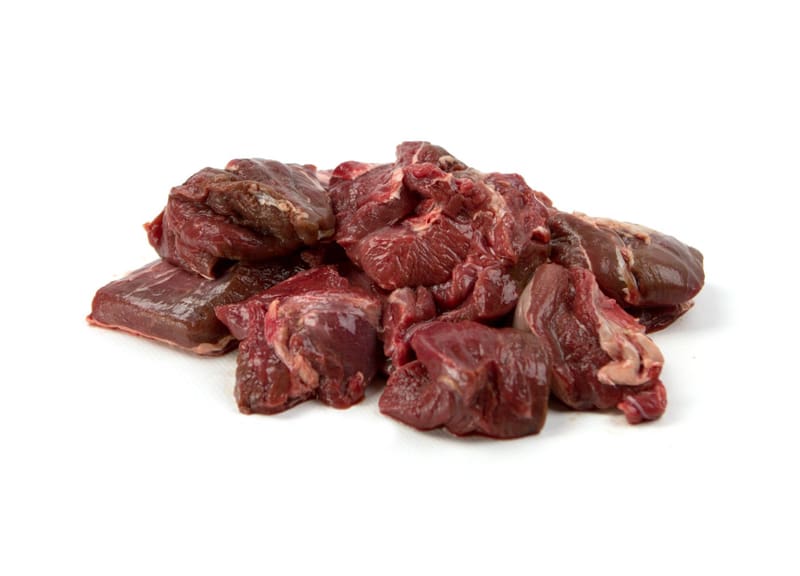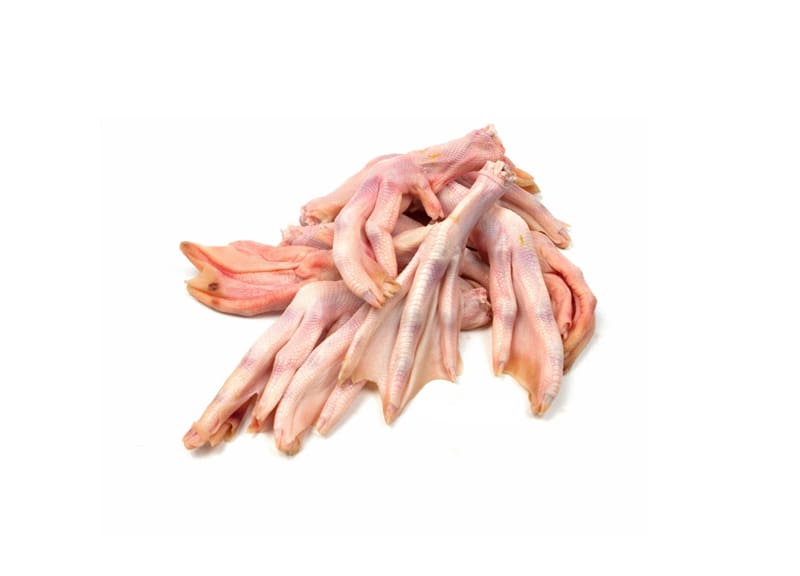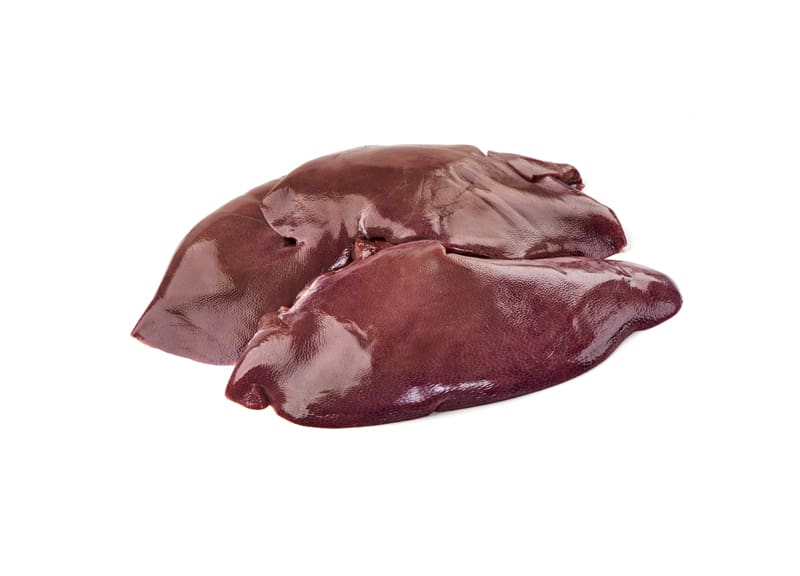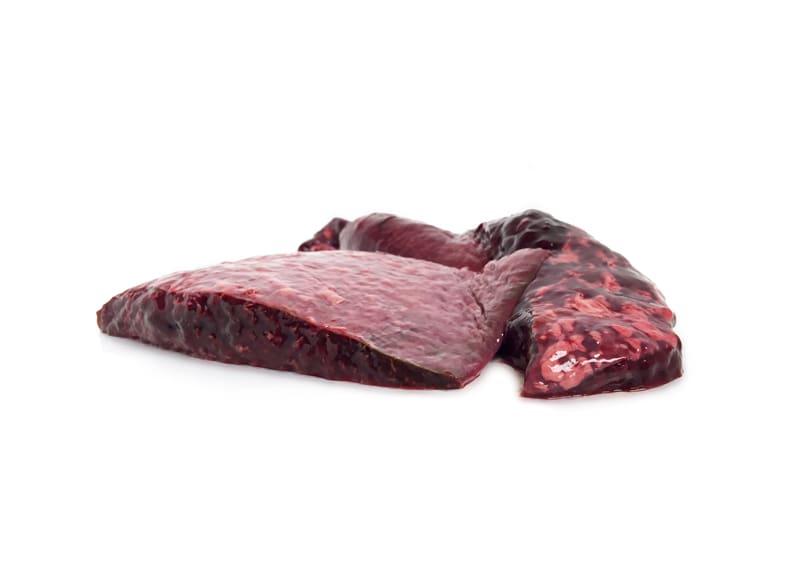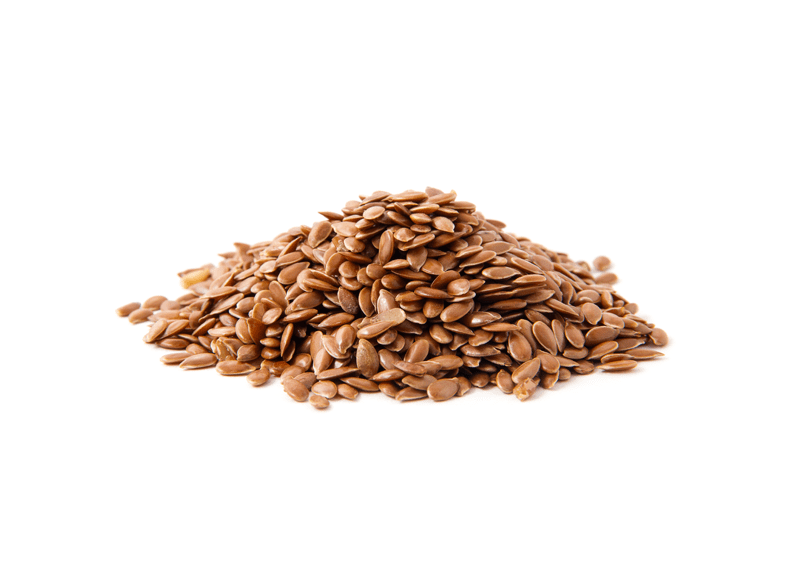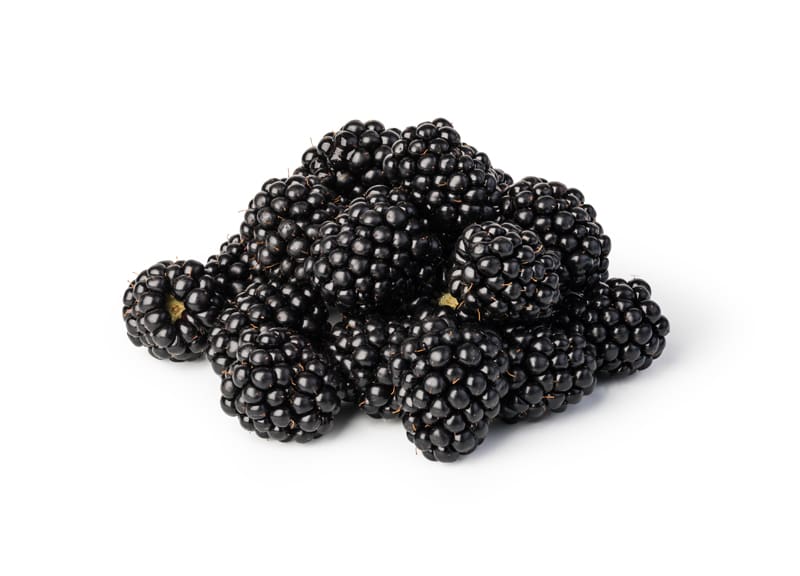The BARF (Biologically Appropriate Raw Food Diet) is an alternative raw diet designed to provide puppies with a modified homemade diet that consists of raw muscle meat and bones, as well as vegetables and fruits while eliminating all processed foods.
The BARF model diet is the most popular raw diet for puppies. A BARF diet can be home prepared with multiple ingredients to provide recommended allowances for most essential nutrients. Although, it is important to note that many ratio raw diets can be lacking in certain essential nutrients when specific whole foods are not fed. Ratio diets are a great base and adding several additional whole foods can help to fill the common nutritional gaps.
BARF Model Raw Diets for Puppies
BARF diet feeding ratios are slightly different from puppy PMR diet ratios to include vegetables, seeds, and fruit.
Adding vegetables, seeds and nuts, and fruit to a puppy’s diet provides many benefits. They often prove useful when formulating a complete and balanced raw diet.
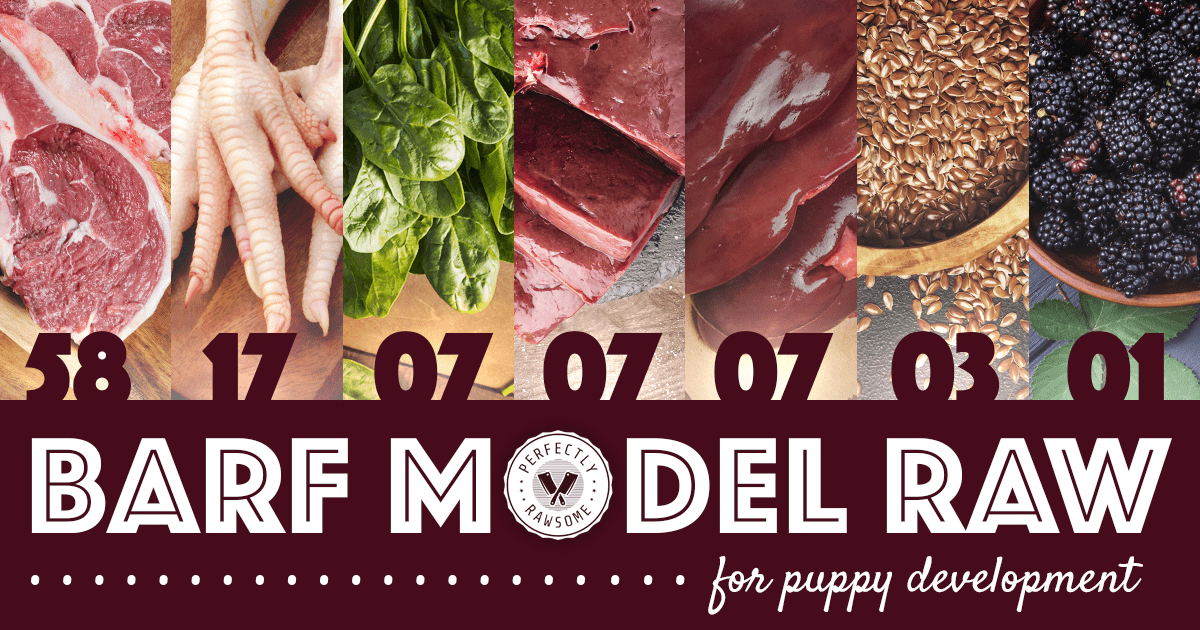
BARF Model Ratio Guidelines
The recommended guidelines for a BARF diet for puppies consists of 58% muscle meat, 17% raw edible bone, 7% vegetables, 7% liver, 7% other secreting organ, 3% seeds or nuts, and 1% fruit.
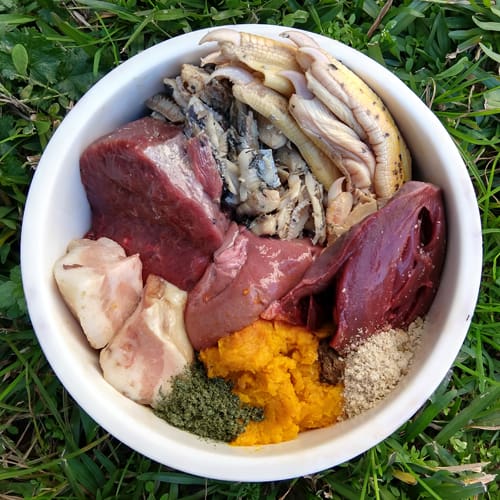
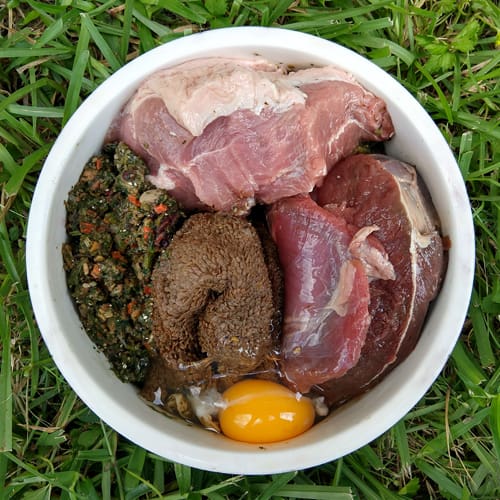
Muscle Meat
BARF diets for puppies consist of raw muscle meat to provide essential protein, amino acids, and water-soluble vitamins. The muscle meat ratio guideline starts at 58% of the overall daily intake.
It is important to note that the muscle meat ratio does not mean to feed muscle meat exclusively. This ratio is a large category containing multiple ingredients such as saturated fat for energy and muscular organs such as heart and tripe.
Raw Edible Bone
Soft, raw edible bones are an important component to BARF diets for puppies to provide essential calcium, phosphorous, and other essential nutrients. The raw edible bone ratio guideline starts at 17% of the overall daily intake. It’s important to note that this ratio refers to the amount of bone alone, and does not include the meat on the bone. Since various raw meaty bones will differ in their bone content, some calculations will be required to know how much of each raw meaty bone to feed.
It is important to note that this ratio refers to the amount of bone only, and does not include the meat on the bone. Since various raw meaty bones will differ in their bone content, some calculations will be required to know how much to feed of each raw meaty bone.
The amount of raw meaty bones a puppy may need to maintain firm and consistent stool will vary. The 17% edible bone ratio is a starting guideline. Many puppies do well on 15% to 20% raw edible bone content. Always adjust according to the puppy’s individual needs.
Vegetables
Vegetables are beneficial ingredients in BARF diets for puppies to provide fiber and beneficial phytochemicals. The vegetable ratio guideline starts at 7% of the overall daily intake.
While not necessarily essential, vegetables are often beneficial for dogs. The 7% ratio guideline is a starting recommendation, and more or less vegetables can be fed depending on the needs of the individual.
Liver
Liver is a very important ingredient in BARF diets for puppies as it provides essential fat-soluble vitamin A and water-soluble vitamins. Ruminant liver also provides the essential mineral copper. The liver ratio guideline is slightly higher in puppy BARF diets to meet their higher needs for essential nutrients during optimal growth. Liver ratio guideline starts at 7% of the overall daily intake.
The 7% liver ratio is a starting guideline and this amount of liver provides more than recommended allowances for vitamin A. For puppies who are sensitive to organs, feeding as low as 5% liver will still provide essential vitamin A. It is recommended to include ruminant liver such as beef or lamb liver in raw diets for puppies.
Other Organs
Other secreting organs, particularly spleen, are important ingredients in BARF diets for puppies to provide essential minerals and water-soluble vitamins. Similar to the liver ratio, the other organ ratio guideline starts at 7% of the overall daily intake.
Other secreting organs are beneficial in completing essential nutrient requirements for puppies. Spleen is recommended in order to meet puppies’ high needs for iron. The 7% ratio guideline is a starting recommendation. More or less may be needed to complete nutritional requirements. It is recommended to include spleen in raw diets for puppies to meet their higher needs for essential iron.
Seeds & Nuts
Raw seeds and nuts are beneficial ingredients in BARF diets for puppies to provide essential minerals, fatty acids, and fat-soluble vitamins. The raw seed and nut ratio guideline starts at 3% of the overall daily intake. This is slightly higher than the recommended amount for adult dogs because puppies have slightly higher needs for certain fatty acids.
Seeds and nuts are beneficial for providing essential fatty acids for puppies, but they must be pre-soaked, drained and ground before feeding. Raw nuts and seeds contain phytates which are anti-nutrients and can negatively affect nutritional balance. Soaking raw seeds and nuts reduces phytates and grinding promotes optimal digestion. The 3% ratio guideline is just a starting recommendation.
Fruit
Fruit is a beneficial ingredient in BARF diets for puppies to provide antioxidants. However, they should only be fed in small amounts due to their sugar levels. The fruit ratio guideline starts at 1% of the overall daily intake.
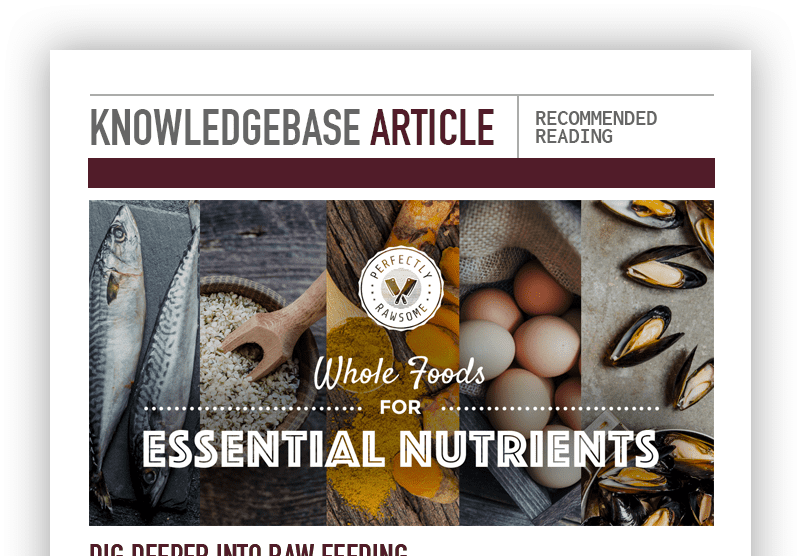
Whole Foods for Essential Nutrients
Many raw diets lack essential nutrients when some specific ingredients are not included. Adding whole foods to a raw diet helps create a balanced diet.
Debunking Myths about Plant Ingredients
The inclusion of plant ingredients in raw diets can create a debate among many. There are many myths associated with feeding plant ingredients to puppies:
Puppies cannot digest plant ingredients.
Puppies can digest and absorb the nutrients from plant ingredients when they are prepared in a method to support optimal digestion. Puréeing raw, non-starchy vegetables is the easiest and most recommended method of preparation. Additionally, lightly steaming or fermenting vegetables are alternative preparation methods to promote optimal digestion. If starchy vegetables are fed, they must be thoroughly cooked before feeding. Boiling or baking starchy vegetables until fully cooked allows the starch to become digestible for puppies.
Vegetables and fruit are not needed for nutrients.
While it is correct to say that vegetables and fruit are not required for essential nutrients, they do play a beneficial role in raw diets. Vegetables and fruit provide carbohydrates which can be used as a source of energy as well as fiber to support vitamin K synthesization and colon health. Vegetables prove useful when completing nutrient requirements in certain situations. Leafy greens are high in magnesium, which is a nutrient often deficient in ratio raw diets. Additionally, specific diets with ingredient restrictions may need to rely on plant ingredients to complete nutritional gaps. An example is low purine diets where organ meats are not fed. Therefore, the use of plant ingredients is warranted to create a complete and balanced diet.
Plant ingredients are not beneficial.
Vegetables and fruit contain carotenoids, flavonoids, antioxidants, and many other phytochemicals that are beneficial to immune function and health. These phytochemicals are not found in any other food sources.
To Feed or Not to Feed Plant Ingredients
Adding vegetables, seeds or nuts, and fruit to a puppy's meal is not harmful in any way when dog-safe ingredients are selected. Puppies can and will digest and absorb the nutrients from plant ingredients when they are prepared to support optimal digestion. Selecting to add plant ingredients to a puppy's meal depends on individual requirements and how the dog tolerates plant ingredients. Always adjust to the puppy's individual needs.
CLOSING COMMENTS
Biologically Appropriate Raw Food (BARF) diets with additional whole foods are a great way to provide a balanced diet to puppies that provide all essential nutrients. Plant ingredients prove beneficial when creating raw diets for puppies.

